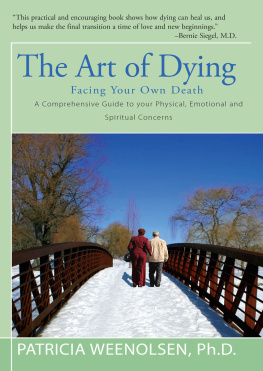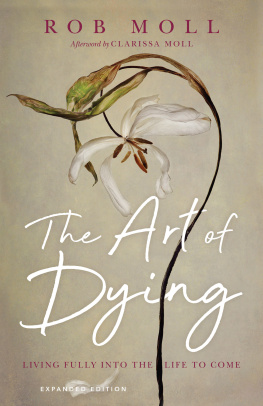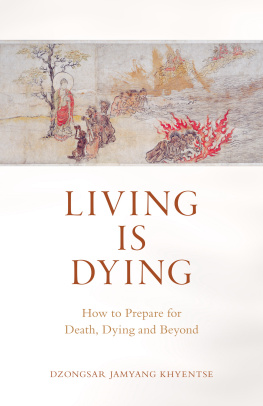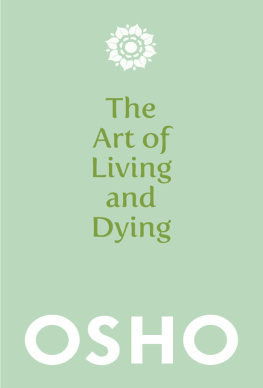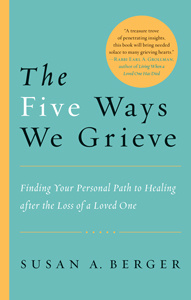The Art of Dying
Facing Your Own Death
Patricia Weenolsen
CONTENTS
More Praise for The Art of Dying
The Art of Dying offers a candid humanistic approach to that which we all must face: death. Each of us must eventually do our own dying, but how much less lonely and frightening the journey can be when we are accompanied by normalcy, understanding, and guidance. This book is written for us all.
Jinny Tesik, nationally certified grief counselor and director of the
Grief & Loss Center, Seattle, Washington
[An] important resource for people facing death as well as for healthcare providers helping them to cope with end-of-life issues. I recommend it highly.
Michael D. Evans, M.D., Group Health Cooperative,
Seattle, Washington
As one who has faced life-threatening illnesses on several occasions, I find The Art of Dying both comforting and inspiring. Dr. Weenolsen has transformed personal death from a terrifying prospect to a more manageable experience practically, and to an extraordinarily positive experience spiritually. As a therapist, I will recommend this book to patients who face the dying of who they are. It will help them immeasurably.
Nancy Logan, M.A., CMHC, therapist, Bellevue, Washington
A thoughtful, compassionate and inspiring handbook from which each and every one of us can derive some benefit. Weenolsens wise counsel pertains to intentional living, no matter where you are in your life span, as well as to making a graceful exit. Weenolsens approach is pragmatic, generous, and gently witty. A commendable job.
Tacoma News Tribune/The News Tribune
[This book] is essential. It is a noteworthy gift. It will bring a significant new awareness to the experience of dying, and with it, lots of awareness for those who walk with the dying and the bereaved. You must read this book.
The Rev. Richard B. Gilbert, MDiv., FAAGC, CPBC/Connections
Weenolsen probes the questions that many may be afraid to ask offers reassurances and comfort.
Newark Star-Ledger
A reassuring yet sensitive approach to difficult subjects.
Library Journal
ALSO BY PATRICIA WEENOLSEN
Transcendence of Loss over the Life Span
Dying, like aging, isnt for sissies! This book is dedicated to all of you courageously facing your own death and the deaths of othersthose of you who have shared your struggles and triumphs with me, those I have yet to meet, those I will never know.
ACKNOWLEDGMENTS
To the following colleagues, I submitted for critique a perfect partial or complete manuscript (their choice) of The Art of Dying. They returned a generously flawed one! I am grateful for their suggestions, most of which I followed: Michael Evans, M.D., physician for the Group Health Cooperative, Seattle; Glenn Gillen, communications coordinator for the National Hospice Organization, Arlington, Virginia; Rabbi Harold Kushner, Temple Israel, Natick, Massachusetts; Nancy Logan, M.A., therapist, Bellevue, Washington; Margo McCaffery, R.N., M.S., FAAN, pain specialist and consultant, Los Angeles; Bernie Siegel, M.D., Woodbridge, Connecticut; M. Brewster Smith, Ph.D., psychology professor emeritus, University of California at Santa Cruz; Jinny Tesik, M.A., director of the Grief and Loss Center, Seattle; and Hannelore Wass, Ph.D., author and editor in the field of death and dying, and psychology professor emeritus, University of Florida, Gainesville.
I also acknowledge my appreciation to the following for the information and other assistance they provided: Harriet A. Fields, E.D., R.N., consultant to the National Citizens Coalition for Nursing Home Reform; Melissa Marott Sirovina, Xerox Corporation, Sacramento and Seattle; Pamela Marott Wellman, R.D., CNSD, Long Beach Community Medical Center, Long Beach, California.
A book isnt born until its sold, edited, and published. For the selling I express thanks to my agent, Ted Chichak, whose faith in the project kept it on track. For the editing and publishing, special praise to senior editor Barbara Anderson, who kept the book afloat with both support and superb, meticulous critique, a delicate balancing act in any editor, wonderfully accomplished by this one. The book and I are fortunate to have her. I thank assistant editor Joy Chang for her wise counsel and many kindnesses. Also thanks to Meg Drislane, Linda Elliot, Elizabeth MacNamara, Gary Cate, Joan Higgins, Charles Rue Woods, Jose Cond, and everyone else at St. Martins.
In any writing endeavor, it is friends and family who make all the difference. For long years of loving support, I am grateful to many, but especially to Valerie Marott, Jennifer Marott, Anne and Dr. Stephen Gray (and little Sean), Dr. Patricia Sullivan and Ray Miller, April and Howard Roseman, Mary Sikkema, Roberta Kehle, Debbie Smith, Frank Mihm, Ron (and Beau) Wilder, and always the University of California, Santa Cruz.
When I think of dedicated service I think of librarians! I have watched you help students research their high school papers; baptize new users of the Internet and Infotrac; magically reveal resources on buying cars, cooking, selling homes, getting jobs, wedding plans, and other practical lifestyle questions; and find esoteric information for scholarsall with a welcome that makes each person feel important. My gratitude particularly to Rae Bass, Judy Evans, and everyone else at the Henry Branch of the Seattle Public Library; to the reference librarians of the downtown library, and last, but not least, to Nancy Pearl, director of the Washington Center for the Book, and Chris HigashiI especially appreciate the opportunity to work in the C. K. Poe Fratt Writers Room. You all deserve the salaries of rock stars and sports heroes! Surely your contributions in preserving and passing on our civilization down through the ages are as worthy.
Finally, as this book goes to press, I have learned that Dr. Elisabeth Kbler-Ross has suffered a stroke and is recuperating in Arizona. Her center is closed, and she no longer teaches her workshops. Elisabeth Kbler-Ross has not reviewed this book, but it owes a debt, as do we all, to her superb pioneering work in the field of death and dying. Many millions of people suffering from bereavement or serious illness have read her books and attended her workshops; there they found the inspiration and courage to go on. Those of us in the field of death and dying are her descendants. May I express heartfelt gratitude, love, and godspeed from all of us.
Patricia Weenolsen, Ph.D.
Seattle, 1995
FOREWORD
This is a book about facing your death. I would like to remind you, however, that until you take your last breath, you are still living. As you know, I believe there may well be a part of us that continues living even beyond our last breath.
So, amazingly enough, the art of dying is really the art of living. Think about it! Trishs suggestions for dying wellforgiving, doing what we love, overcoming loss, praying, connecting with the sacred, even making legal and medical preparations in a caring mannerall these are about living well! What is hard is

